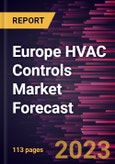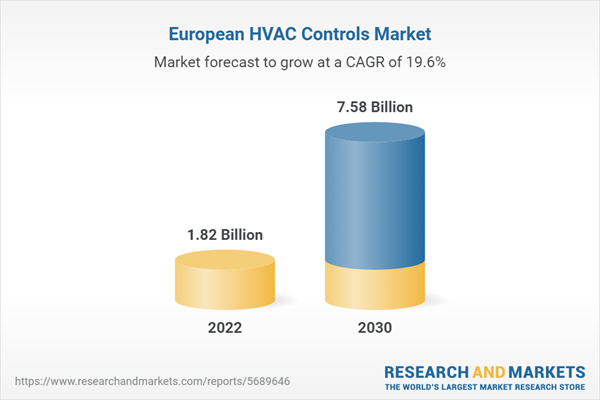Development of Smart Cities Drive Europe HVAC Controls Market
Various governments across the world are taking initiatives to develop smart cities in their respective economies due to the rising trend of urbanization. Moreover, the European Commission (EC) aims to significantly promote energy-efficient and low-carbon technologies under its Smart Cities Initiative. Therefore, the increasing focus of governments worldwide on the development of smart cities is expected to create lucrative opportunities for the Europe HVAC controls market during the forecast period.Europe HVAC Controls Market Overview
The Europe HVAC controls market is segmented into Germany, France, Russia, the UK, Italy, and the Rest of Europe. In Germany, the HVAC control system provides warmth or cooling in residential, commercial, or industrial building areas and fresh outdoor air to remove interior airborne contaminants, including volatile organic compounds and odors released by interior fixtures or different cleaning agents. The market growth in Europe is primarily driven by increased housing projects, growing construction spending, rising government investment in green building initiatives, fast urbanization, and rising disposable income. In European countries, such as the UK, Germany, and France, the government rules addressing energy efficiency and the use of environment-friendly refrigerants are projected to enhance the demand for HVAC equipment. Over the past ten years, the UK and France have built a comprehensive regulatory framework and binding targets for the transportation and building sectors under European commitments to boost energy efficiency by 20% by 2021.The French organization Smart Buildings Alliance (SBA) works to advance the smart building sector in smart cities. The alliance has brought together 170 organizations from various trades within the building sector (industrial companies, service companies, builders, developers, design offices, architects, developers, and innovative startups). Moreover, the rising initiatives for sustainable building development in Europe will offer lucrative opportunities to HVAC control manufacturers. For instance, huge European cities and businesses committed to reducing their building's CO2 emissions to zero in December 2019. As part of the agreement, major participants in the construction industry, including BuroHappold, Deerns, Carbon Credentials, and Grimshaw Architects, joined Helsinki and Valladolid in signing the World Green Building Council's Net Zero Carbon Buildings Commitment. Also, in May 2023, Johnson Controls expanded its collection of residential and commercial contractor resources with the new Johnson Controls Ducted Systems (DS) Solutions App. The free app provides contractors instant access to commercial and residential equipment information to help streamline installation, troubleshooting, and maintenance processes. Thus, all the aforementioned factors are positively influencing the Europe HVAC controls market.
Europe HVAC Controls Market Revenue and Forecast to 2030 (US$ Million)
Europe HVAC Controls Market Segmentation
The Europe HVAC controls market is segmented into component, installation type, system, end user, and country.Based on component, the Europe HVAC controls market is bifurcated into hardware and software & services. In 2022, the hardware and software segment registered a larger share in the Europe HVAC controls market. The hardware segment is further segmented into sensor, controllers, smart vents, and others.
Based on installation type, the Europe HVAC controls market is bifurcated into new installation and retrofit. In 2022, the retrofit segment registered a larger share in the Europe HVAC controls market
Based on system, the Europe HVAC controls market is segmented into temperature control system, humidity control system, ventilation control system, and integrated control system. In 2022, the temperature control system segment registered the largest share in the Europe HVAC controls market.Based on end user industry, the Europe HVAC controls market is segmented into residential, commercial, and industrial. In 2022, the commercial segment registered the largest share in the Europe HVAC controls market.
Based on country, the Europe HVAC controls market is segmented into the UK, Germany, France, Italy, Russia, and the Rest of Europe. In 2022, the UK registered the largest share in the Europe HVAC controls market.
Carrier Global Corporation; DAIKIN INDUSTRIES, Ltd.; Acuity Brands, Inc.; Emerson Electric Co.; Honeywell International Inc.; Johnson Controls, Inc.; Schneider Electric SE; Siemens AG; and Lennox International Inc. are some of the leading companies operating in the Europe HVAC controls market.
Table of Contents
Executive Summary
At 19.6% CAGR, the Europe HVAC Controls Market is Speculated to be worth US$ 7,582.79 million by 2030.According to this research, the Europe HVAC controls market was valued at US$ 1,815.69 million in 2022 and is expected to reach US$ 7,582.79 million by 2030, registering a CAGR of 19.6% from 2022 to 2030. Implementation of smart, connected, and energy efficient IOT-enabled HVAC systems and development of smart cities are the critical factors attributed to the Europe HVAC controls market expansion.
Lighting and HVAC systems use the most energy in commercial or residential buildings. Air conditioners and electric fans contribute to ~20% of the total electricity consumption in a building. As per a report by International Energy Agency (IEA), the energy demand from air conditioners is expected to grow three times by 2050. Implementation of IoT into HVAC systems enables remote appliance control and significantly better customer-centric services. Main advantage of integrating IoT in the energy sector is the operational insight into HVAC appliances and techniques to reduce energy usage significantly. HVAC contractors can get their devices to monitor occupancy inside the building by combining smart devices with motion sensors. The system might recommend that the customer dial down the heating (or cooling) to save energy through an app message when there is no movement for an extended time inside the building. Moreover, the controls use the most recent networking and AI technologies, enabling them to gradually learn the preferences of the tenants and adapt to their comfort requirements. HVAC manufacturers aim to grow their market share by offering consumers intelligent HVAC solutions. Implementation of machine-to-machine (M2M) connectivity with IoT in various applications supports cost savings, resource conservation, predictive maintenance, comfort control, and healthy building performance. As a result, there is a higher need for IoT-based HVAC control systems. Thus, implementation of smart, connected, and energy-efficient IoT-enabled HVAC systems bolsters the Europe HVAC controls market growth.
On the contrary, high cost and technical complexities hurdles the growth of Europe HVAC controls market.
Based on component, the Europe HVAC controls market is bifurcated into hardware and software & services. The hardware and software segment held 61.0% share of Europe HVAC controls market in 2022, amassing US$ 1,107.53 million. It is projected to garner US$ 4,784.47 million by 2030 to expand at 20.1% CAGR during 2022-2030. The hardware segment is further segmented into sensor, controllers, smart vents, and others.
Based on installation type, the Europe HVAC controls market is bifurcated into new installation and retrofit. The retrofit segment held 67.4% share of Europe HVAC controls market in 2022, amassing US$ 1,223.52 million. It is projected to garner US$ 5,317.68 million by 2030 to expand at 20.2% CAGR during 2022-2030.
Based on system, the Europe HVAC controls market is segmented into temperature control system, humidity control system, ventilation control system, and integrated control system. The temperature control system segment held 38.6% share of Europe HVAC controls market in 2022, amassing US$ 700.97 million. It is projected to garner US$ 3,212.55 million by 2030 to expand at 21.0% CAGR during 2022-2030.
Based on end user industry, the Europe HVAC controls market is segmented into residential, commercial, and industrial. The commercial segment held 57.2% share of Europe HVAC controls market in 2022, amassing US$ 1,038.62 million. It is projected to garner US$ 4,579.14 million by 2030 to expand at 20.4% CAGR during 2022-2030.
Based on country, the Europe HVAC controls market is segmented into the UK, Germany, France, Italy, Russia, and the Rest of Europe. Our regional analysis states that the UK captured 30.1% share of Europe HVAC controls market in 2022. It was assessed at US$ 545.98 million in 2022 and is likely to hit US$ 2,543.95 million by 2030, exhibiting a CAGR of 21.2% during 2022-2030.
Key players operating in the Europe HVAC controls market report Carrier Global Corporation; DAIKIN INDUSTRIES, Ltd.; Acuity Brands, Inc.; Emerson Electric Co.; Honeywell International Inc.; Johnson Controls, Inc.; Schneider Electric SE; Siemens AG; and Lennox International Inc., among others.
Companies Mentioned
- Acuity Brands, Inc.
- Carrier Global Corporation
- DAIKIN INDUSTRIES, Ltd.
- Emerson Electric Co.
- Honeywell International Inc.
- Johnson Controls, Inc.
- Lennox International Inc.
- Schneider Electric SE
- Siemens AG
Table Information
| Report Attribute | Details |
|---|---|
| No. of Pages | 113 |
| Published | December 2023 |
| Forecast Period | 2022 - 2030 |
| Estimated Market Value in 2022 | 1.82 Billion |
| Forecasted Market Value by 2030 | 7.58 Billion |
| Compound Annual Growth Rate | 19.6% |
| Regions Covered | Europe |
| No. of Companies Mentioned | 9 |









